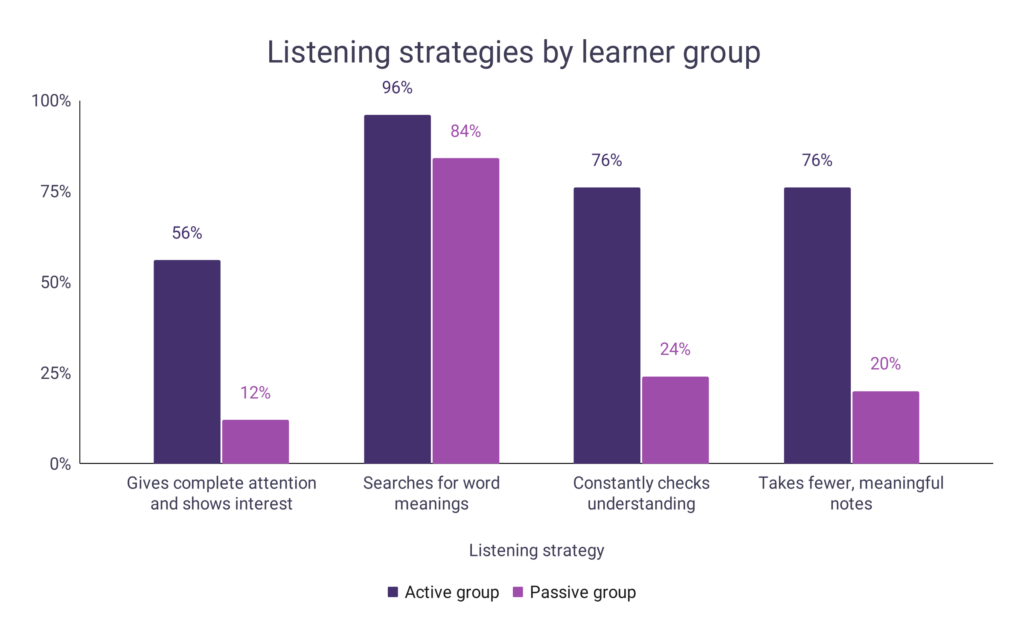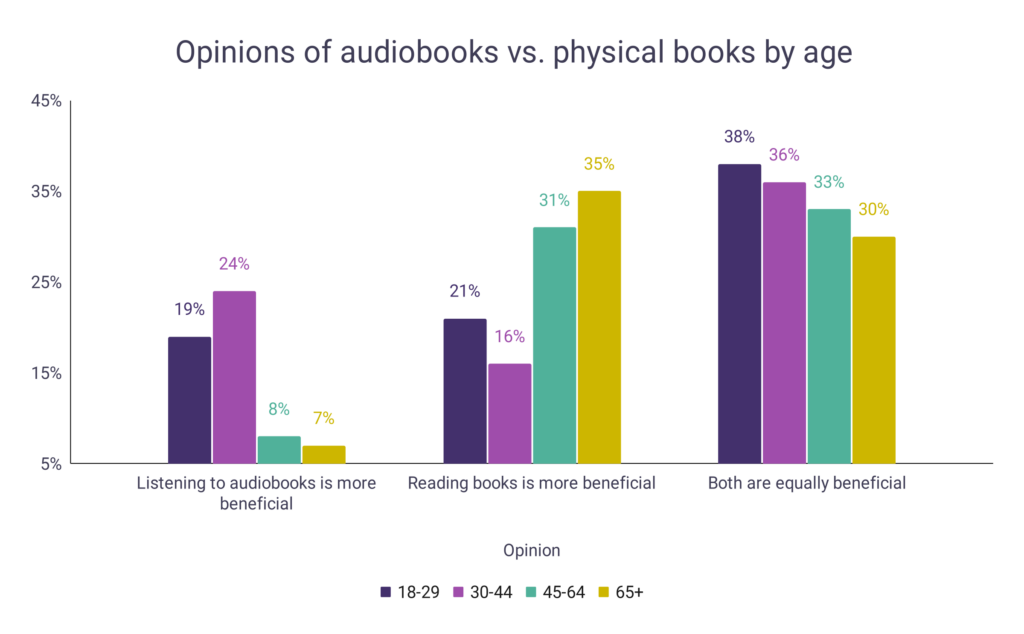In this article, WordsRated takes a look at trends related to listening and our navigation through daily life using the auditory sense. The manner in which we listen differs from person-to-person and those who master the skill of active listening enhance their chance of gaining and retaining knowledge, while also increasing their vocabulary.
- One study finds that 45% of a person’s time awake is engaged in some kind of listening, which amounts to around 7.58 hours per day for US citizens.
- Each person hears between 20,000 – 30,000 words each day, which on average amounts to around 0.3 – 0.5 words per second during time awake.
- This totals 20 – 30 words per minute or 1,200 – 1,800 words per hour.
- In contrast, the average person speaks 16,000 words a day, between 4,000 – 14,000 words less than we hear.
- One survey found that 96% of people believe themselves to be good listeners.
- On average, a person who hasn’t developed their listening skills can understand and retain around 50% of a conversation immediately after it has taken place.
- Within 48 hours, this drops to under 25% retention.
- In the workplace, more than 70% of employees are believed to be affected by poor listening skills/habits.
- In terms of the things we learn, around 85% is due to listening to information.
- Around 30% of the population are auditory learners, who learn best through listening to information and processing it.
- Problem-solving skills can be negatively affected by listening to nagging or complaining for more than 30 minutes.
- Formal education on how to listen properly has only been undertaken by less than 2% of the population.
Time spent listening
- Listening has been shown to be the most common style of communication (45%).
- Speaking, which is usually performed in tandem with listening, is the second-most common (30%).
- More time is spent listening than both writing and reading combined (25%).
| Rank | Communication style | Percent of time spent |
| #1 | Listening | 45% |
| #2 | Speaking | 30% |
| #3 | Writing | 16% |
| #4 | Reading | 9% |
A graph is given below to compare the frequency of listening vs. other communication styles:

Listening effect on health and wellbeing
- Listening to 30 minutes or more of nagging/complaining can negatively affect the brain’s problem-solving skills.
- Math scores have been seen to increase by 12% when students listen to classical music while studying.
- In a study, patients who listen to music before surgery saw their cortisol levels decrease.
- This resulted in them having lower anxiety than patients who were instead given drugs.
- Diners who hear relaxing music when in restaurants are found to consume 175 fewer calories on average.
- The likelihood of a teenager committing a driving error reduces from 98% to 78% when listening to relaxing music instead of their favorite tunes.
- Research has shown that women engage both hemispheres of their brain when listening, whereas men typically rely on just one.
Listening in the workplace
- Active listening is identified by 64% of HR professionals as the most critical leadership skill.
- However, more than 50% of managers do not listen to their employees in an effective manner.
- Employee satisfaction has been shown to increase by 30% after managers go through training in active listening.
- Being able to actively listen is shown to increase productivity and collaboration by up to 25%.
- It is also shown to reduce the number of misunderstandings by 40%.
- Sales performance can even be improved by 8% through active listening.
Improving listening in the workplace
- A survey found that 85.54% of employees believe they possess effective listening skills.
- Marginally lower, 84.30% believe they have coworkers or supervisors that also demonstrate this skill.
- However, despite these high numbers, just 34.30% of employees said they have received training on their workplace communication/listening skills.
- 58.26% of employees feel that this kind of training would be helpful to them in the workplace.
| Question | Yes | No | No answer |
| Do you possess effective listening skills? | 85.54% | 3.72% | 10.74% |
| Do any of your coworkers and supervisors possess effective listening skills? | 84.30% | 11.98% | 3.72% |
| Have you had any training on communication/listening skills in the workplace? | 34.30% | 41.74% | 23.97% |
| Would training on communication/listening skills be helpful for you in the workplace? | 58.26% | 14.88% | 26.86% |
Listening strategies
A 2011 study attempted to look at the listening strategies of English as a foreign language students. Students were split into active and passive learners, based on their IQ, attention span and class participation.
- A greater percentage of students in the active group used varied listening strategies when compared with the passive group.
- Active participants were 4.67 times more likely to report giving complete attention and showing interest.
- They were 3.17 times more likely to continuously check their understanding.
- Active learners were also 3.80 times more likely to take fewer, meaningful notes.
| Listening strategy | Active group | Passive group |
| Gives complete attention and shows interest | 56% | 12% |
| Searches for word meanings | 96% | 84% |
| Constantly checks understanding | 76% | 24% |
| Takes fewer, meaningful notes | 76% | 20% |
A graph is given below to compare listening strategies by learner group:

Opinions on reading books vs. listening to audiobooks
Even though studies have shown that we predominantly learn through listening, opinions on the benefits of book formats differ.
- Just 14% of US adults believe that audiobooks are more beneficial than physical books.
- 26% say that physical books provide more benefits.
- However, 34% believe that they are equally beneficial.
| Opinion | 18-29 | 30-44 | 45-64 | 65+ | All |
| Listening to audiobooks is more beneficial | 19% | 24% | 8% | 7% | 14% |
| Reading books is more beneficial | 21% | 16% | 31% | 35% | 26% |
| Both are equally beneficial | 38% | 36% | 33% | 30% | 34% |
A graph is given below to compare the opinions on reading books vs. listening to audiobooks by age:

Listening FAQ
What is the difference between hearing and active listening
- Hearing is the physical process that allows us to perceive sound through our ears.
- In contrast, active listening is what happens mentally when we concentrate on a sound and try to derive meaning from it.
- Whereas hearing requires minimal effort, active listening requires us to focus our attention on the sound(s) being heard, before using contemplation and reasoning skills to form conclusions that we may use in response.
How can I improve my listening skills?
- There are a number of ways in which we can improve our listening skills when practiced with regularity. These include:
- Face the speaker and maintain eye contact to show respect and your engagement in the conversation.
- Maintain a relaxed attitude, reinforcing your interest and providing a comfortable space to share ideas.
- Allow the speaker adequate time to put their point across instead of interrupting and/or jumping to assumptions.
- Be open minded and willing to understand what is being said instead of entering with preconceptions.
- Show interest to the speaker through positive, open body language such as head nodding.
- Pay attention to the speaker’s body language, which may help you pick up on secondary information.
What are the different listening styles?
- Listening styles can be split into four distinct categories, which are:
- People-oriented – The listener tries to find common ground with the speaker, tuning into their emotions, feelings and moods.
- Action-oriented – The listener looks for clear and organized messages and will likely pick-up on inconsistencies in information.
- Content-oriented – The listener will favor technical information and is likely to evaluate the whole argument before forming their own opinion.
- Time-oriented – The listener is less interested in detail, values efficiency and prefers the information to jump straight to the point.
- Around 40% of people typically utilize multiple styles at any time of listening.
- Action-oriented and time-oriented listeners are likely to prefer command words that are shorter in nature (for example: those using 7-letters or less)
How many words can the average listener process per minute?
- Per minute, the average person can listen to upwards of 400 words.
- Despite this, people typically speak much slower, between 135 – 175 words per minute.
- Due to the difference in speed between what is being heard and processing power of the brain, listeners can lose their attention span.
- Listeners’ thoughts can turn to what to say next, mentally processing and contemplating the information or just simply daydreaming.
- These internal thoughts may differentiate comprehension between those that are fully focused on listening and those who are not.

